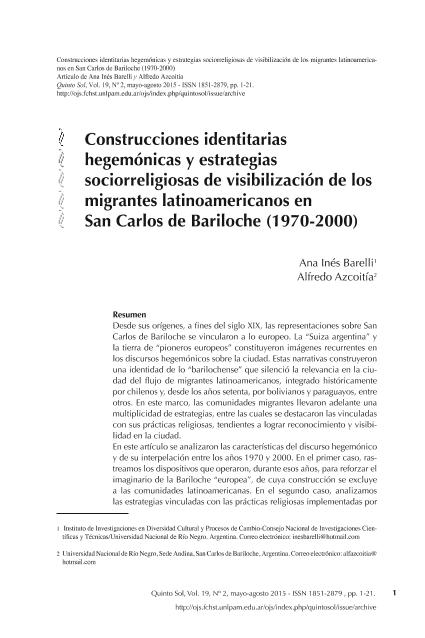Mostrar el registro sencillo del ítem
dc.contributor.author
Barelli, Ana Inés

dc.contributor.author
Azcoitia, Alfredo

dc.date.available
2020-08-28T11:45:16Z
dc.date.issued
2015-09
dc.identifier.citation
Barelli, Ana Inés; Azcoitia, Alfredo; Construcciones identitarias hegemónicas y estrategias socio-religiosas de visibilización de los migrantes latinoamericanos en San Carlos de Bariloche (1970-2000).; Universidad Nacional de La Pampa.Facultad de Ciencias Humanas.Instituto de Estudios Socio-Históricos.; Quinto Sol; 19; 2; 9-2015; 1-21
dc.identifier.issn
0329-2665
dc.identifier.uri
http://hdl.handle.net/11336/112603
dc.description.abstract
Desde sus orígenes, a fines del siglo XIX, las representaciones sobre San Carlos de Bariloche se vincularon a lo europeo. La “Suiza argentina” y la tierra de “pioneros europeos” constituyeron imágenes recurrentes en los discursos hegemónicos sobre la ciudad. Estas narrativas construyeron una identidad de lo “barilochense” que silenció la relevancia en la ciudad del flujo de migrantes latinoamericanos, integrado históricamente por chilenos y, desde los años setenta, por bolivianos y paraguayos, entre otros. En este marco, las comunidades migrantes llevaron adelante una multiplicidad de estrategias, entre las cuales se destacaron las vinculadas con sus prácticas religiosas, tendientes a lograr reconocimiento y visibilidad en la ciudad. En este artículo se analizaron las características del discurso hegemónico y de su interpelación entre los años 1970 y 2000. En el primer caso, rastreamos los dispositivos que operaron, durante esos años, para reforzar el imaginario de la Bariloche “europea”, de cuya construcción se excluye a las comunidades latinoamericanas. En el segundo caso, analizamos las estrategias vinculadas con las prácticas religiosas implementadas por estas comunidades, en articulación con la Iglesia católica rionegrina, para interpelar ese discurso en la esfera pública.
dc.description.abstract
From its origins, at the end of the 19th century, the representations on San Carlos de Bariloche were linked to European issues. The “Argentinian Switzerland” and the land of “European pioneers” became images that constituted hegemonic discourses about the city. These narratives constructed an identity of “barilochenses” that silenced the relevancy in the city of the flow of Latin-American migrants, integrated historically by Chileans and from the seventies by Bolivians and Paraguayans, among others. In this context, communities of migrants carried through a multiplicity of strategies, among which those related to their religious practices standed out, since they intended to achieve recognition and visibility in the city. In this paper we analyze the characteristics of the hegemonic discourse and its interpellation between 1970 and 2000. In the first case we will trace the devices that operated, during these years, to reinforce the imaginary one of an “European” Bariloche, where Latin-American communities are excluded from this construction. Secondly, we will analyze the strategies linked with religiousness implemented by these communities, in its relationship with Rio Negro church, to interpellate this discourse within the public sphere.
dc.format
application/pdf
dc.language.iso
spa
dc.publisher
Universidad Nacional de La Pampa.Facultad de Ciencias Humanas.Instituto de Estudios Socio-Históricos.
dc.rights
info:eu-repo/semantics/openAccess
dc.rights.uri
https://creativecommons.org/licenses/by-nc-sa/2.5/ar/
dc.subject
REPRESENTACIONES
dc.subject
RELIGIOSIDAD
dc.subject
MIGRANTES LATINOAMERICANOS
dc.subject
SAN CARLOS DE BARILOCHE
dc.subject.classification
Otras Historia y Arqueología

dc.subject.classification
Historia y Arqueología

dc.subject.classification
HUMANIDADES

dc.title
Construcciones identitarias hegemónicas y estrategias socio-religiosas de visibilización de los migrantes latinoamericanos en San Carlos de Bariloche (1970-2000).
dc.title
Hegemonic constructions of identity and socio-religious strategies of visibility of Latin-American migrants in San Carlos de Bariloche (1970-2000)
dc.type
info:eu-repo/semantics/article
dc.type
info:ar-repo/semantics/artículo
dc.type
info:eu-repo/semantics/publishedVersion
dc.date.updated
2020-07-21T21:01:42Z
dc.identifier.eissn
1851-2879
dc.journal.volume
19
dc.journal.number
2
dc.journal.pagination
1-21
dc.journal.pais
Argentina

dc.journal.ciudad
Santa Rosa
dc.description.fil
Fil: Barelli, Ana Inés. Consejo Nacional de Investigaciones Científicas y Técnicas. Centro Científico Tecnológico Conicet - Patagonia Norte. Instituto de Investigaciones en Diversidad Cultural y Procesos de Cambio. Universidad Nacional de Río Negro. Instituto de Investigaciones en Diversidad Cultural y Procesos de Cambio; Argentina
dc.description.fil
Fil: Azcoitia, Alfredo. Consejo Nacional de Investigaciones Científicas y Técnicas. Centro Científico Tecnológico Conicet - Patagonia Norte. Instituto de Investigaciones en Diversidad Cultural y Procesos de Cambio. Universidad Nacional de Río Negro. Instituto de Investigaciones en Diversidad Cultural y Procesos de Cambio; Argentina. Universidad Nacional de Río Negro; Argentina
dc.journal.title
Quinto Sol
dc.relation.alternativeid
info:eu-repo/semantics/altIdentifier/url/https://cerac.unlpam.edu.ar/index.php/quintosol/article/view/1046
Archivos asociados
